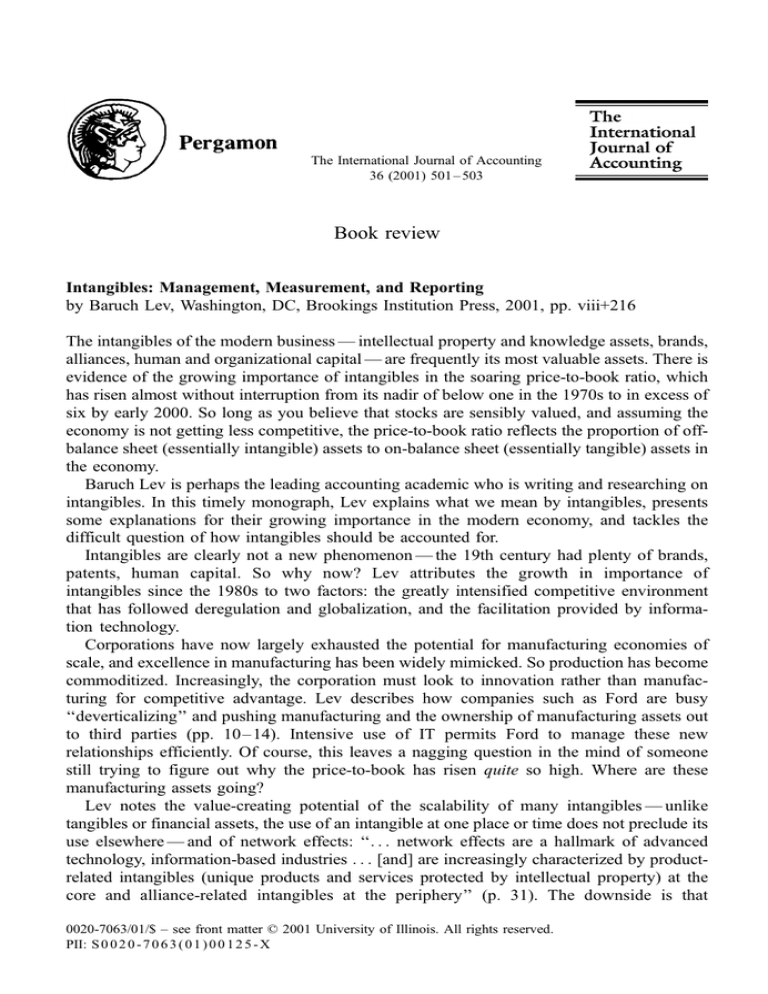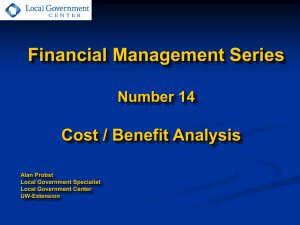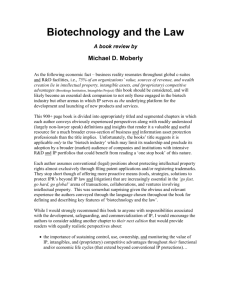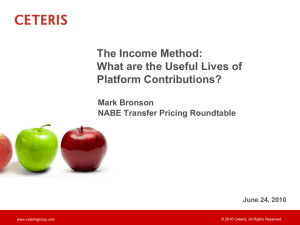
The International Journal of Accounting
36 (2001) 501 – 503
Book review
Intangibles: Management, Measurement, and Reporting
by Baruch Lev, Washington, DC, Brookings Institution Press, 2001, pp. viii+216
The intangibles of the modern business — intellectual property and knowledge assets, brands,
alliances, human and organizational capital — are frequently its most valuable assets. There is
evidence of the growing importance of intangibles in the soaring price-to-book ratio, which
has risen almost without interruption from its nadir of below one in the 1970s to in excess of
six by early 2000. So long as you believe that stocks are sensibly valued, and assuming the
economy is not getting less competitive, the price-to-book ratio reflects the proportion of offbalance sheet (essentially intangible) assets to on-balance sheet (essentially tangible) assets in
the economy.
Baruch Lev is perhaps the leading accounting academic who is writing and researching on
intangibles. In this timely monograph, Lev explains what we mean by intangibles, presents
some explanations for their growing importance in the modern economy, and tackles the
difficult question of how intangibles should be accounted for.
Intangibles are clearly not a new phenomenon — the 19th century had plenty of brands,
patents, human capital. So why now? Lev attributes the growth in importance of
intangibles since the 1980s to two factors: the greatly intensified competitive environment
that has followed deregulation and globalization, and the facilitation provided by information technology.
Corporations have now largely exhausted the potential for manufacturing economies of
scale, and excellence in manufacturing has been widely mimicked. So production has become
commoditized. Increasingly, the corporation must look to innovation rather than manufacturing for competitive advantage. Lev describes how companies such as Ford are busy
‘‘deverticalizing’’ and pushing manufacturing and the ownership of manufacturing assets out
to third parties (pp. 10–14). Intensive use of IT permits Ford to manage these new
relationships efficiently. Of course, this leaves a nagging question in the mind of someone
still trying to figure out why the price-to-book has risen quite so high. Where are these
manufacturing assets going?
Lev notes the value-creating potential of the scalability of many intangibles — unlike
tangibles or financial assets, the use of an intangible at one place or time does not preclude its
use elsewhere — and of network effects: ‘‘. . . network effects are a hallmark of advanced
technology, information-based industries . . . [and] are increasingly characterized by productrelated intangibles (unique products and services protected by intellectual property) at the
core and alliance-related intangibles at the periphery’’ (p. 31). The downside is that
0020-7063/01/$ – see front matter D 2001 University of Illinois. All rights reserved.
PII: S 0 0 2 0 - 7 0 6 3 ( 0 1 ) 0 0 1 2 5 - X
502
Book review / The International Journal of Accounting 36 (2001) 501 – 503
investments in intangibles are often far more risky than investments in tangibles, partly
because of the very winner-take-all nature of network economics. Also, intangibles are
bedeviled by fuzzy property rights and the difficulty of excluding outsiders from enjoyment
of the intangibles.
People are clearly the key to innovation, and CEOs unceasingly remind us that its people
are the corporation’s most important asset. However, ‘‘human capital’’ raises in stark form a
central difficulty of the intangibles economy. Employees are making it increasingly clear that
they are not, in any meaningful sense, assets. They can walk. Lev quotes a striking finding:
that over 70% of young, fast-growing companies were created by people simply replicating or
developing innovations from their previous employer (p. 35). In such a world it remains an
open question how much of the value created by the new economy will be left with
stockholders in public markets, and how much will be captured by key employees.
The growth of intangibles has exposed the limitations of the existing accounting model.
The question that is constantly asked by the innocent nonaccountant is: if intangibles are so
important, why aren’t they on the balance sheet? This debate surfaced energetically over a
decade ago when a small number of leading branded goods firms in the UK and elsewhere
started to include a valuation of their brand equity in the balance sheet. The practice did not
become widespread, and recent accounting standards reflect the current consensus, which is
that internally generated intangibles cannot be usefully included in the balance sheet.
Intangibles do not meet accountants’ tests for balance sheet recognition for several reasons.
Intangibles are frequently diffuse in nature and not readily separable from other assets or from
the business as a whole. The fuzzy property rights surrounding many intangibles mean that
the company may not exercise the ‘‘effective control’’ required of an asset. The paradox is
that it is the uniqueness of its intangibles that enables the firm to differentiate itself and helps
it to sustain competitive advantage. But, being unique, there is no active secondary market in
similar assets to which accountants can refer to get a market price. So the valuation of
intangibles necessarily involves subjective evaluations of future cash flows.
The debate about whether the firm should value its intangibles in the balance sheet is over.
The new challenge is disclosure. At present, firms have very little guidance on what
information they should usefully disclose to enable outsiders to evaluate their intangibles.
Throughout the book, Lev associates the creation of intangibles with the process of
innovation, and the ‘‘innovation value chain’’ provides the framework for Lev’s template for
a new set of corporate disclosures (Chapter 5). Lev proposes a detailed series of disclosures
under three broad headings: learning activities and the discovery of new ideas, implementation, and commercialization. His proposals jibe with those of other writers who have been
calling for systematic disclosure of the way in which management targets and measures the
creation of shareholder value. A key element in this work will be the increasing alignment of
internal and external reporting.
There is a long way to go in developing an accounting model for the world of intangibles.
While templates such as Lev’s are well articulated, there is a lot of research still needed before
we can define a parsimonious and robust set of metrics for, say, brand equity or human capital.
Observation of companies’ current internal reporting systems suggests that they are using a
wide variety of metrics to measure the performance of these assets. If the appropriate metrics
Book review / The International Journal of Accounting 36 (2001) 501 – 503
503
for intangibles is quite context-specific, it will be challenging to develop accounting rules that
bring forth more useful disclosure. The supply of information on intangibles will need to be
matched by demand. At present, both supply and demand are very weak. Unless equity
analysts and other outsiders can use the data that companies are producing, attempts to
improve disclosure will be frustrated. It is going to be fascinating to watch the debate proceed.
Chris Higson
London Business School








